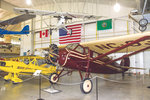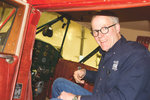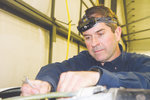Nationally known as a center for the traditional maritime trades, the Quimper Peninsula also launches aircraft and aeronautics careers from a hands-on training center at the Port Townsend Aero Museum.
Restoring airplanes once hopelessly stuck on terra firma brings great pleasure to the mechanics at the Port Townsend Aero Museum, said director Mike Payne.
This item is available in full to subscribers.
We have recently launched a new and improved website. To continue reading, you will need to either log into your subscriber account, or purchase a new subscription.
If you had an active account on our previous website, then you have an account here. Simply reset your password to regain access to your account.
If you did not have an account on our previous website, but are a current print subscriber, click here to set up your website account.
Otherwise, click here to view your options for subscribing.
* Having trouble? Call our circulation department at 360-385-2900, or email our support.
Please log in to continue |
|



Nationally known as a center for the traditional maritime trades, the Quimper Peninsula also launches aircraft and aeronautics careers from a hands-on training center at the Port Townsend Aero Museum.
Restoring airplanes once hopelessly stuck on terra firma brings great pleasure to the mechanics at the Port Townsend Aero Museum, said director Mike Payne.
But even more fulfilling is that aeronautical engineers of the future have a hand in bringing the old planes back to life, Payne added.
“We are lucky here because that entire process involves kids,” Payne said. “We’ve got three mechanics including myself that are responsible for overseeing these 16 different kids that volunteer here.”
The youth mentorship program pairs up teens as young as 13 with the seasoned airplane mechanics who volunteer their time at the museum, Payne said, with the goal of providing valuable technical skills, leadership experience and a taste of serious responsibility.
The youth volunteers are involved in every step of the process, Payne added, from the moment an old rust bucket arrives in the museum hangar to when it finally lifts off.
“It is a piece of them. At 15, that is an amazing feeling. That is what gets me in here” Payne added, pounding his chest.
There have been over 400 kids in the program since its inception, Payne said.
“Some of those kids were here a month, and some of them were here for seven years,” he said. “There is a wide variety.”
Some went on to become airline pilots or engineers. One even earned a doctorate in aviation at MIT, Payne said.
“It is pretty impressive,” he said. “Given the tools and the opportunity, they can all be exceptional.”
Arriving in pieces
Oftentimes, old planes that have been grounded for years arrive at the museum in shambles.
Jack Becker, volunteer mechanic and board member of the museum, currently is working with students to rebuild a replica of a Granville Brothers Gee Bee Model E Sportster.
The original Model Es were first built in the early 1930s, Becker said. The replica was built in the 1980s, but has been grounded for over a decade following a crash.
“It was last flown, I believe, in 2004,” Becker said. “There was a little accident where it nosed over on landing and damaged the top of the tail.”
The mechanics at a now-shuttered museum in Concrete, Washington undertook repairs, but the plane was never re-assembled before the Port Townsend Aero Museum acquired it, Becker said.
“The motor was off, the wings were off, the tail was off,” Becker said. “Basically, we received it as a kit.” With the wings and several boxes of parts stashed in a hangar at The Aero Museum, Becker and and his students have been working steadily on the Model E since early January.
“As I am going through the assembly of it, there are some little things that need to be redone, that we didn’t know,” he said.
Those repairs are being done with the help of the students, Becker said.
A date when the plane will be finished has yet to be determined, but it will be flight worthy again, Payne said.
“Different restorations involve different amounts of time, depending on the airplane and finances, too,” he said. “Museum airplanes, we tend to do maybe one a year — either a refurbishment or a full restoration — depending on the aircraft. A year ago it was our Piper cub that we refurbished and got looking like new. The year before, we finished a Travel Air 2000 (open cockpit biplane) … (with) a whole bunch of kids helping.”
A repository for forgotten planes
Before the museum can get to work on a new project, they first either have to purchase a plane, or have one donated. As a 501-c3 nonprofit organization, donors may receive a tax write-off for any such donations.
Payne said he is excited about a recent donation that has a storied history, a Piper Cherokee PA-28-140, which was designed for training and initially shipped with only two seats.
The aircraft was the first of its series off the assembly line, which is proven by its serial number of 0000. “This is the very first one,” Payne said. “That makes it kind of unique.”
Since this plane was the first to be manufactured, it had the distinction of being used as the photographic model for the original brochure, Payne said.
Because of that, Aero Museum crews know exactly what the original paint scheme was and will reproduce that when finishing the project.
The plane’s story doesn’t end there Payne said.
“Somewhere out there is black and white footage of some man or woman winning this airplane,” he said. In 1964, the aircraft was flown to Hollywood, California where it was given away on the “Price is Right” game show, said Payne, citing the log books.
Now, 55 years later, the plane is receiving a second chance at life.
“It is being reborn here with the help of a whole bunch of the kids working on it,” Payne said. “It is a perfect project for the kids because it is very labor intensive and you can turn them loose on it.”
And once finished, the plane will make an excellent training tool to teach students to fly, Payne said.
Refurbishing privately owned planes
The museum also services and refurbishes planes for private customers as a way to raise needed funds for the museum, Payne said.
Richard Taracka, aircraft mechanic, said he helps maintain or refurbish about 45 customer airplanes annually.
Taracka currently is working on an Ercoupe 415C, which he said was manufactured in the late 1940s.
“I am conducting an annual inspection on it,” he said. “It is basically just looking over all the critical parts of the aircraft to make sure everything is working the way it should and not wearing out or broken. It is always a good feeling to find something that can potentially cause a problem that has not been corrected. That is very rewarding when that happens.”
Taracka has been a pilot for about 25 years, and a mechanic for the last 12, he said.
“I have loved aircraft as long as I can remember,” he said, adding “it is a pretty amazing feeling watching an airplane that you have restored fly for the first time.” He lives the serious responsibility students are learning through Aero Museum programs. “It is kind of stressful, too, because you kind of wonder, did I do everything right?”
Most everything in house
The planes are painted in-house, with most parts also made on site because they are no longer mass-manufactured and available from parts supply houses, Payne said.
“If it is beyond our capability, we have to find somebody that has that capability, and that tends to be a real specialist.”
That requires a large amount of networking, Payne said.
“How they did this before the internet, I don’t know,” he said. “It would have been a lot tougher — a lot of phone calls and just knowing everybody in the industry.”
Once all the parts are fabricated, the plane is cleaned up painted and then reassembled, Payne said.
Seeing the finished product is quite a sight to behold, Taracka said.
“As far as the antiques go, it is rewarding just because of how beautiful they turn out, he said.
On display
The museum currently has more than twenty restored aircraft on display in the main hangar of the $3.5 million facility built in the summer of 2008.
All but about three wouldn’t need much to get off the ground, Payne said.
“The ones that are hanging were air-worthy when we hung them,” he said. “To fly them now, we would have to let them down and do an inspection. And then they would be ready to go.”
The Port Townsend Aero Museum is located at 191 Airport Cutoff Road. For more information, call 360-379-5244 or visit http://ptaeromuseum.com